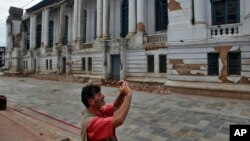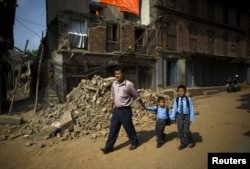Nepal has reopened its major world heritage sites to try to woo tourists to return to the country shattered by the massive April earthquake, despite some concerns over safety. The huge hit to the tourism sector in the wake of the disaster has been a double blow to the poor Himalayan nation which is heavily dependent on money spent by visitors.
After sweeping aside debris and cordoning off centuries-old structures severely damaged by the April 25 quake, Nepalese authorities threw open many popular heritage sites early Monday.
These include three former “durbar” or royal squares in Kathmandu, Patan and Bhaktapur. Their glittering palaces and historic temples attracted tens of thousands of tourists, particularly from neighboring India.
In Bhaktapur, after a ceremony by dancers and musicians, Tourism Minister Kripasur Sherpa urged people to come to the country for a vacation “to help Nepal rebuild.”
A senior official at the Nepal Tourist Board, Aditya Baral, says they want to send out a message that Nepal is safe and wants to host tourists with “renewed enthusiasm.”
“Government is trying to show that this is a tourism-friendly country and [that] devastation, that was in the past, but now people have recouped and they have come into normal life. You know, people still have some fear psychosis to travel to Nepal,” said Baral.
Uphill battle
However, luring tourists back may be an uphill battle. In a statement last week, the U.N. cultural agency, UNESCO, expressed concern over reopening the heritage sites and asked the public to be extra cautious. It said that some sites are still in a precarious state.
But Nepalese officials are confident that there are no risks. They say visitors will be given guided tours and only allowed to visit the safe structures. In some places they will even be given safety helmets.
Some iconic structures such as the 60-meter tall Dharahara Tower in the Kathmandu Durbar Square collapsed as a result of the powerful earthquake, and hundreds of other ancient heritage sites - big and small - were damaged. But many iconic temples and palaces survived virtually intact.
Those involved in the tourism and travel industry in Nepal say “highly exaggerated” media reports of damage to Nepal’s infrastructure and cultural heritage sites scared away tourists from the country.
Tourism officials say everything from the Kathmandu airport, to most hotels, and communication links are functional to stress that “things are normal.”
Managing Director of the luxury Shangri-La Hotel in Kathmandu, Prasidha Panday, said much of the Nepalese capital is back on its feet. He sees no reason for visitors to stay away.
“If you just look at the last couple of weeks, all the cafes, clubs, restaurants, everything, it has all come to life. That way, I don’t feel it should not be a problem. Once people are here, they will realize, impact is not as it has been projected,” said Panday.
He added that things are already improving – at one of his properties in Pokhara, another tourist magnet, occupancy is up from “zero” a month ago to about thirty percent.
Low-income workers hit hard
The government’s bid to woo back tourists comes as nearly half a million people dependent on income from tourism, such as porters, guides and waiters are finding it extremely difficult to rebuild lives shattered by the earthquake as they are left with no livelihood.
Hare Ram Baral, head of the Tourist Guide Association of Nepal, said the situation is bleak for thousands of low-income workers.
“Ninety percent of the tour guides are unemployed, they have no work, they are jobless. There is insecurity among the tour guides [about] what to do. I have [asked] my colleagues, just wait for one year.”
Even as Nepal worries about getting its tourist economy back in shape, there are also concerns about rebuilding its damaged heritage.
Aditya Baral of the Nepal Tourism Board said it will be a painstaking task that could take many years.
“It’s not like building a new house. Government is trying to give training. It’s a long term process,” said Baral.
The effort to restore the damaged heritage structures is being led by UNESCO and is estimated to cost some $18 million.







